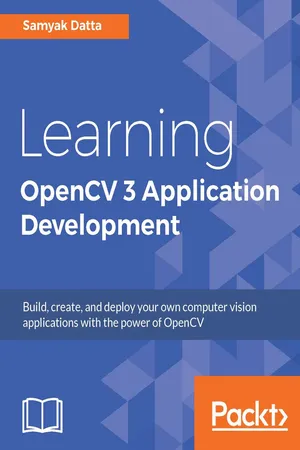
Learning OpenCV 3 Application Development
Samyak Datta
- 310 pages
- English
- ePUB (mobile friendly)
- Available on iOS & Android
Learning OpenCV 3 Application Development
Samyak Datta
About This Book
Build, create, and deploy your own computer vision applications with the power of OpenCV
About This Book
- This book provides hands-on examples that cover the major features that are part of any important Computer Vision application
- It explores important algorithms that allow you to recognize faces, identify objects, extract features from images, help your system make meaningful predictions from visual data, and much more
- All the code examples in the book are based on OpenCV 3.1 – the latest version
Who This Book Is For
This is the perfect book for anyone who wants to dive into the exciting world of image processing and computer vision. This book is aimed at programmers with a working knowledge of C++. Prior knowledge of OpenCV or Computer Vision/Machine Learning is not required.
What You Will Learn
- Explore the steps involved in building a typical computer vision/machine learning application
- Understand the relevance of OpenCV at every stage of building an application
- Harness the vast amount of information that lies hidden in images into the apps you build
- Incorporate visual information in your apps to create more appealing software
- Get acquainted with how large-scale and popular image editing apps such as Instagram work behind the scenes by getting a glimpse of how the image filters in apps can be recreated using simple operations in OpenCV
- Appreciate how difficult it is for a computer program to perform tasks that are trivial for human beings
- Get to know how to develop applications that perform face detection, gender detection from facial images, and handwritten character (digit) recognition
In Detail
Computer vision and machine learning concepts are frequently used in practical computer vision based projects. If you're a novice, this book provides the steps to build and deploy an end-to-end application in the domain of computer vision using OpenCV/C++.
At the outset, we explain how to install OpenCV and demonstrate how to run some simple programs. You will start with images (the building blocks of image processing applications), and see how they are stored and processed by OpenCV. You'll get comfortable with OpenCV-specific jargon (Mat Point, Scalar, and more), and get to know how to traverse images and perform basic pixel-wise operations.
Building upon this, we introduce slightly more advanced image processing concepts such as filtering, thresholding, and edge detection. In the latter parts, the book touches upon more complex and ubiquitous concepts such as face detection (using Haar cascade classifiers), interest point detection algorithms, and feature descriptors. You will now begin to appreciate the true power of the library in how it reduces mathematically non-trivial algorithms to a single line of code!
The concluding sections touch upon OpenCV's Machine Learning module. You will witness not only how OpenCV helps you pre-process and extract features from images that are relevant to the problems you are trying to solve, but also how to use Machine Learning algorithms that work on these features to make intelligent predictions from visual data!
Style and approach
This book takes a very hands-on approach to developing an end-to-end application with OpenCV. To avoid being too theoretical, the description of concepts are accompanied simultaneously by the development of applications. Throughout the course of the book, the projects and practical, real-life examples are explained and developed step by step in sync with the theory.
Frequently asked questions
Information
Learning OpenCV 3 Application Development
Learning OpenCV 3 Application Development
Credits
| Author Samyak Datta | Copy Editor Safis Editing |
| Reviewer Nikolaus Gradwohl | Project Coordinator Sheejal Shah |
| Commissioning Editor Kunal Parikh | Proofreader Safis Editing |
| Acquisition Editor Sonali Vernekar | Indexer Rekha Nair |
| Content Development Editor Nikhil Borkar | Graphics Abhinash Sahu |
| Technical Editor Hussain Kanchwala | Production Coordinator Shraddha Falebhai |
About the Author
About the Reviewer
www.PacktPub.com

Why subscribe?
- Fully searchable across every book published by Packt
- Copy and paste, print, and bookmark content
- On demand and accessible via a web browser
Preface
What this book covers
Table of contents
- Learning OpenCV 3 Application Development